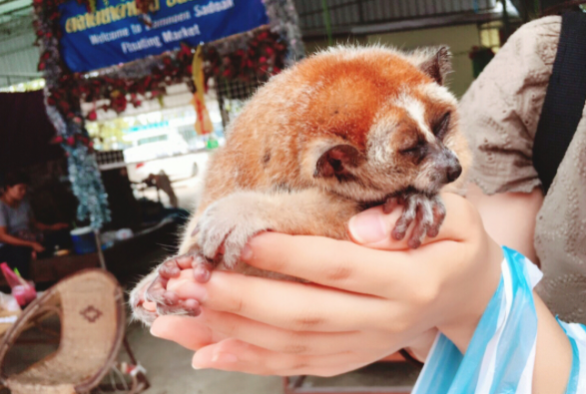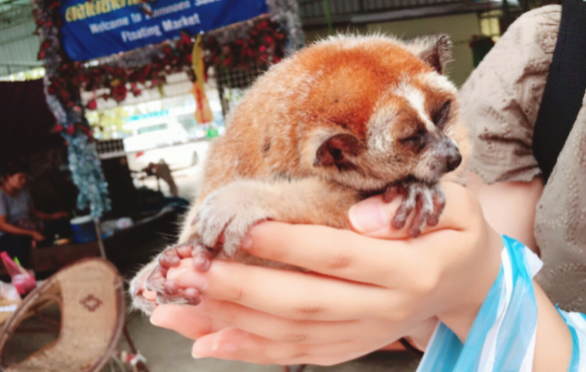The drive to produce popular Instagram content can lead individuals to overlook animal welfare. Opportunities for an exciting photograph or selfie with a threatened species are rife in many global tourism hotspots. Last week this blog series covered the conservation concerns of celebrities and Instagram influencers, a consequence of influencers posting inappropriate content of wildlife is that in can increase demand from their fans to emulate. This entry will discuss the growing issue of two-shot images (containing both an animal and a human) with photo-prop animals and harmful approaches to tourism.
Obtaining wildlife for the photo prop industry is often by means of tracking wild fauna and killing a parent with an infant, leaving them orphaned. The infant is then collected and reared in a captive setting for entertainment use, including selfie opportunities. Adults can suffer too – for example it is just as, if not even more common, for adult slow lorises to be caught for this trade. Animals can be maimed and altered to increase ease of handling. Primates, for example, may be drugged or have their teeth removed, which could decrease their ability to enact natural behaviours. A 2013 blog from LFP depicted the growing trend of slow lorises in Phuket, Thailand as photo props; prized for their cuteness, they are an obvious choice. Once mature or ill, props are often abandoned. However, this context is lost or not explained when an Instagram picture depicts a smiling tourist with a seemingly ‘happy’ animal during an exotic holiday.

Small animals are usually the chief victims. Many appear on chains held by a handler in holiday sites. Barbary macaques are used as photo props in Marrakech, Morocco at top tourist sites such as Jemaa el-Fna square. Despite prohibition to sell or own Barbary macaques and presence on the IUCN Red List, these vulnerable animals are still heavily monopolised as photo props. While not universally appealing, handlers profit from naïve tourists wanting a unique Instagram upload. These interactions can be more explicitly inappropriate, and many tourists are repelled by poor housing conditions. Read more about the relationship tourists have with photo prop macaques here.
Unfortunately, creative means to allude tourists occur and can be less obvious with. This can make spotting criminal activity more difficult. A guise of ‘sanctuary’ is a common tool to lure affluent tourists into more ethical means of exotic animal interaction. True sanctuaries recognise the five freedoms and if an animal is advertised as able to return to the wild, it should have minimal human interaction. Misconceptions are easily seen with the case of elephant ‘sanctuaries’. In Thailand, elephant-related tourism that includes photo-opportunities is a £415 million-a-year industry according to 2022 figures. ‘Sanctuaries ‘are a huge pull factor for international tourists, however in many cases elephants are mistreated and expected to perform to a crowd. In addition to being incredibly harmful to individual mental health, long-lasting injury and disease can occur from poor husbandry, as shown with inappropriate elephant rides causing spine deformities. According to Save The Asian Elephants (STAE), commercial exploitation is a key catalyst for wild population decline due to disruptive, live capture from their natural habitat. Read more about this here.
Navigating ethical tourism can be hard and Instagram behaviour must be considered. To avoid contributing to negative consequences while travelling, do not interact with roadside handlers and if seen, report to local authorities and tourist board. Read more on good practice here.
Please remember, even one picture with these threatened animals contributes to their poor quality of life and fuels a dramatically cruel industry.
I would like to point your attention to Oxford Brookes MSc Primate Conservation, Monkey Monday talk. This week Lauren Arnaud and Nicola O’Brien explored social media’s role in primate exploitation, you can check out this important seminar here.
See you next Friday!
Jacob Callicott
Further reading

